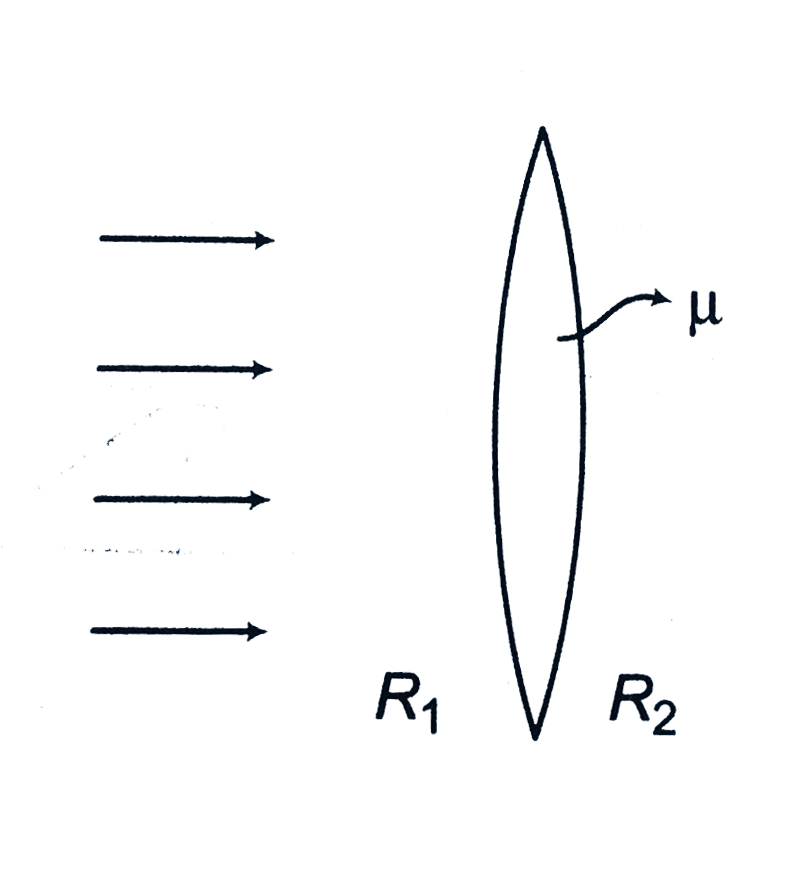A convex lens of radii of curvature 20cm and 30 cm respectively. It is silvered at the surface which has smaller radius of curvature. Then it will behave as (μg=1.5)
concave mirror with equivalent focal length 3011cm.
concave mirror with equivalent focal length 6011cm.
convex mirror with equivalent focal length 3011cm.
convex mirror with equivalent focal length 6011cm.
The correct Answer is:B
To solve the problem step by step, we will use the lens maker's formula and the properties of mirrors.
Step 1: Identify the given values
- Radii of curvature: R1=20cm (convex side), R2=−30cm (concave side, negative due to sign convention)
- Refractive index of glass: μg=1.5
Step 2: Use the lens maker's formula
The lens maker's formula is given by:
1fl=(n−1)(1R1−1R2)
Substituting the values:
1fl=(1.5−1)(120−1−30)
=0.5(120+130)
Step 3: Calculate 120+130
Finding a common denominator (which is 60):
120=360,130=260
Thus,
120+130=3+260=560=112
Step 4: Substitute back into the lens maker's formula
1fl=0.5×112=124
So,
fl=24cm
Step 5: Determine the focal length of the silvered surface
Since the lens is silvered at the surface with the smaller radius of curvature (20 cm), it behaves like a concave mirror. The focal length of a mirror is given by:
fm=−R2
For the silvered surface:
fm=−202=−10cm
Step 6: Combine the focal lengths of the lens and the mirror
The equivalent focal length feq of the combination of the lens and the mirror is given by:
1feq=1fl+1fm
Substituting the values:
1feq=124+1−10
Finding a common denominator (which is 120):
124=5120,1−10=−12120
Thus,
1feq=5−12120=−7120
So,
feq=−1207≈−17.14cm
Step 7: Conclusion
Since the focal length is negative, the combination behaves like a concave lens (or mirror).
Final Answer
The system behaves like a concave mirror with an equivalent focal length of approximately −17.14cm.
---
- Radii of curvature: R1=20cm (convex side), R2=−30cm (concave side, negative due to sign convention)
- Refractive index of glass: μg=1.5
The lens maker's formula is given by:
1fl=(n−1)(1R1−1R2)
Substituting the values:
1fl=(1.5−1)(120−1−30)
=0.5(120+130)
Finding a common denominator (which is 60):
120=360,130=260
Thus,
120+130=3+260=560=112
1fl=0.5×112=124
So,
fl=24cm
Since the lens is silvered at the surface with the smaller radius of curvature (20 cm), it behaves like a concave mirror. The focal length of a mirror is given by:
fm=−R2
For the silvered surface:
fm=−202=−10cm
The equivalent focal length feq of the combination of the lens and the mirror is given by:
1feq=1fl+1fm
Substituting the values:
1feq=124+1−10
Finding a common denominator (which is 120):
124=5120,1−10=−12120
Thus,
1feq=5−12120=−7120
So,
feq=−1207≈−17.14cm
Since the focal length is negative, the combination behaves like a concave lens (or mirror).
The system behaves like a concave mirror with an equivalent focal length of approximately −17.14cm.
Topper's Solved these Questions
- RAY OPTICS AND OPTICAL INSTRUMENTSBook:NCERT FINGERTPS ENGLISHChapter:RAY OPTICS AND OPTICAL INSTRUMENTSExercise:Reflection Of Light By Spherical Mirrors
Explore 5 Videos
- RAY OPTICS AND OPTICAL INSTRUMENTSBook:NCERT FINGERTPS ENGLISHChapter:RAY OPTICS AND OPTICAL INSTRUMENTSExercise:Refraction
Explore 10 Videos
- RAY OPTICS AND OPTICAL INSTRUMENTSBook:NCERT FINGERTPS ENGLISHChapter:RAY OPTICS AND OPTICAL INSTRUMENTSExercise:ASSERTION AND REASON
Explore 15 Videos
- PRACTICE PAPPERBook:NCERT FINGERTPS ENGLISHChapter:PRACTICE PAPPERExercise:Practice Paper 3
Explore 50 Videos
- SEMICONDUCTOR ELECTRONICS : MATERIALS , DEVICES AND SIMPLE CIRCUITS Book:NCERT FINGERTPS ENGLISHChapter:SEMICONDUCTOR ELECTRONICS : MATERIALS , DEVICES AND SIMPLE CIRCUITS Exercise:Assertion And Reason
Explore 15 Videos
Similar Questions
A plano convex lens of radius of curvature 30 cm and refractive index 1.5 is kept in air. Find its focal length (in cm).
View SolutionThe focal length of a convex mirror is 20 cm its radius of curvature will be
View SolutionFor a plane convex lens (μ=1.5) has radius of curvature 10 cm. It is slivered on its plane surface. Find focal length after silvering:
View SolutionA thin plano-convex lens acts like a concave mirror of radius of curvature 20cm when its plane surface is silvered. The radius of curvature of the curved surface if index of refraction of its matarial is 1.5 will be
View SolutionA thin plano-convex lens acts like a concave mirror of radius of curvature 20cm when its plane surface is silvered. The radius of curvature of the curved surface if index of refraction of its matarial is 1.5 will be
View SolutionA biconvex lens (μ=1.5) has radius of curvature 20cm (both).
find its focal length.

View SolutionThe concave and convex surface of a thin concavo-convex lens of refractive index 1.5 has radius of curvature 50 cm and 10 cm respectively. The concave side is slivered then if the equivalent focal length of the silvered lends is −5xcm then find x.
View SolutionA diverging meniscus lens of radii of curvatures 25 cm and 50 cm has a refractive index 1.5. Its focal length is (in cm)
View SolutionIf the plane surface of a plano-convex lens of radius of curvature R and refractive index μ is silvered, then its focal length would be
View SolutionA beam of light coming from infinty is passing through a biconvex lens having radius of curvature R=20cm of each surface, if focused at a certain distance from lens. Find the radius of curvature of emergent wave front from lens : (μ≤ns=1.5)
View Solution